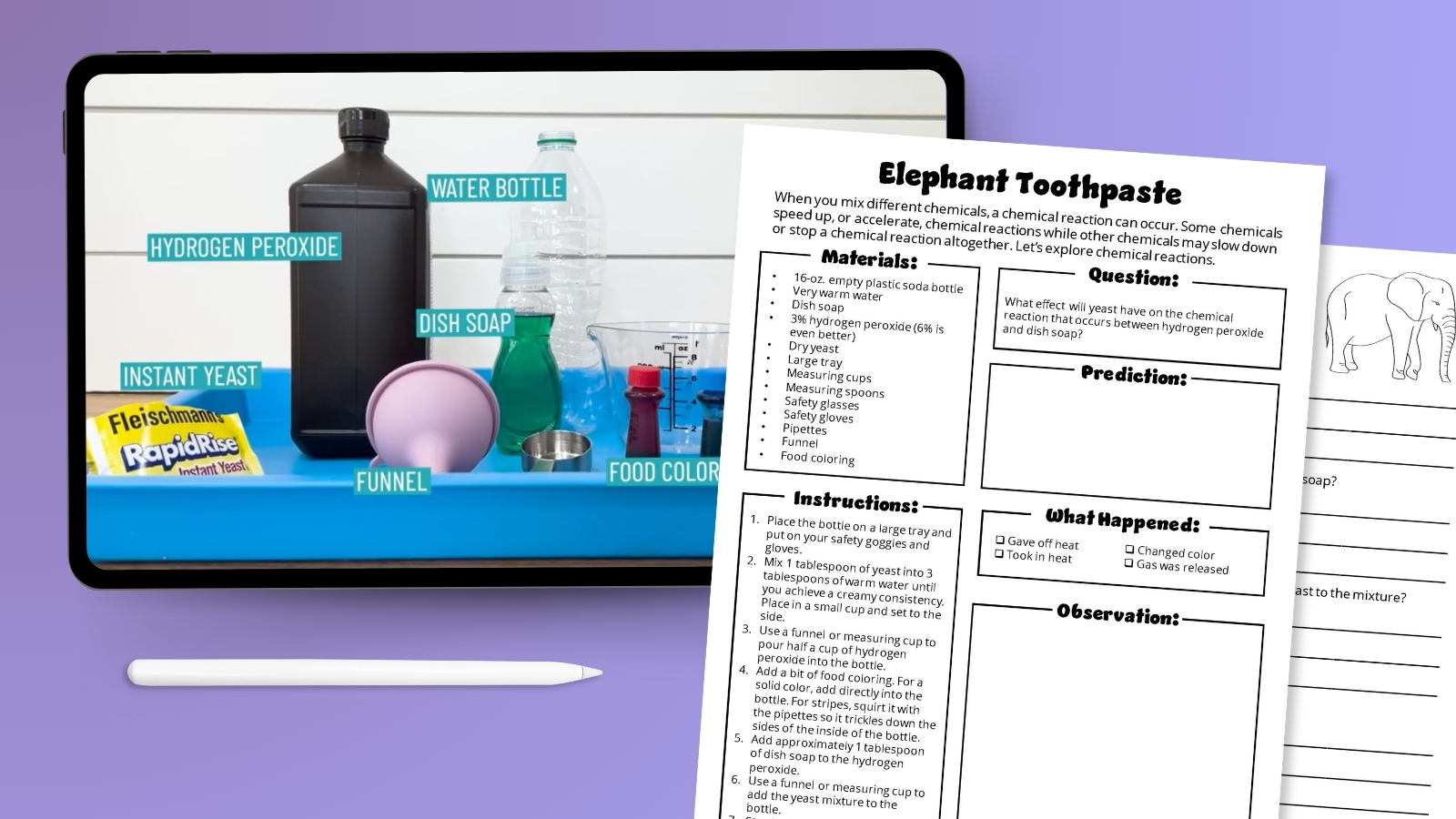Who knew toothpaste could be so fun? While no actual toothpaste is produced, this experiment is an exciting and hands-on way to bring several science lessons to life. You’ll want to use some caution when performing it with kids. Some of the chemicals used can be irritating and the substance produced is hot, so you won’t want to actually brush anyone’s teeth with the foam, as tempting as that may be! Read on to see how to do the Elephant Toothpaste Experiment, and fill out the form on this page to grab your free recording sheet.
How does the Elephant Toothpaste Experiment work?
This experiment works through a chemical reaction that results from a catalyst (potassium iodide, aka yeast) being introduced into a mixture of hydrogen peroxide and dish soap. The hydrogen peroxide is decomposed into water and oxygen and the catalyst speeds up the reaction, forcing the oxygen into the soap bubbles. The resulting effect is the substance quickly pouring up and out of the container.
What does the Elephant Toothpaste Experiment teach?
This experiment is a crowd-pleaser, but it also serves to teach kids a lot. The concept of a catalyst speeding up a reaction is demonstrated in an obvious and exciting way as the introduction of the yeast forces the foam to explode up and out of the bottle. It also teaches kids about exothermic reactions as the foam coming out of the bottle is hot. Additionally, kids get to see a decomposition reaction as the rapid decomposition of hydrogen peroxide results in the release of oxygen gas.
Is there an Elephant Toothpaste Experiment video?
This video from teacher Hilary Statum will give you the step-by-step instructions for making your own Elephant Toothpaste.
Materials Needed
To do the experiment, you will need:
- 16-oz. empty plastic soda bottle
- Very warm water
- Dish soap
- 3% hydrogen peroxide (6% is better, if available)
- Dry yeast
- Large tray
- Measuring cups
- Measuring spoons
- Safety glasses
- Safety gloves
- Pipettes
- Funnel or measuring cup with a lip
- Food coloring
Our free recording sheet is also helpful—fill out the form on this page to get it!
Elephant Toothpaste Experiment steps:
1. Place the bottle on a large tray and put on your safety goggles and gloves.
2. Mix 1 tablespoon of yeast into 3 tablespoons of warm water until you achieve a creamy consistency. Place in a small cup and set to the side.
3. Use a funnel or measuring cup to pour half a cup of hydrogen peroxide into the bottle.
4. Add a bit of food coloring. For a solid color, add directly into the bottle. For stripes, squirt it with the pipettes so it trickles down the sides of the inside of the bottle.
5. Add approximately 1 tablespoon of dish soap to the hydrogen peroxide.
6. Use a funnel or measuring cup to add the yeast mixture to the bottle.
7. Step back and watch the explosion!
Grab our free Elephant Toothpaste Experiment worksheet!

Fill out the form on this page to get your worksheets. The first worksheet asks kids to make a prediction about what they think will happen. They can use the provided spaces to draw or write their predictions and observations. The second worksheet lists questions for students to answer about the experiment.
Additional Reflection Questions

- Why do we add the yeast to the water?
- What do you think would happen if we added more dish soap?
- What do you think would happen if we added more yeast to the mixture?
- What is the liquid that is left in the bottle?
- Describe the reaction that occurs. How long does it last?
Can this experiment be done for a science fair?
Yes! If you want to do the Elephant Toothpaste Experiment for a science fair, we recommend switching up some of the variables. For example: Does the type or shape of the container matter? Does the type of dish soap matter? Does adding more yeast change the reaction? Form a hypothesis about how changing the variables will impact the experiment. Good luck!

